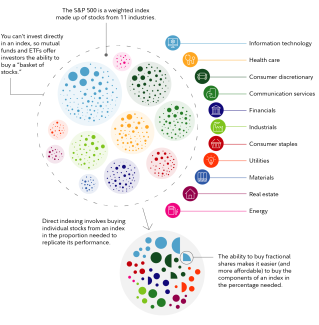
Cranbrook Wealth is partnering with Fidelity and Goldman Sachs to offer Direct Indexing Separately Managed Accounts to their clients
What is direct indexing?
Direct indexing is an investment strategy designed to replicate the performance of an index, like the S&P 500 for example. This is done by selecting an index whose performance you want to replicate, and then buying a representative amount of all that particular index’s components individually.
Making direct indexing accessible to more investors
Historically, this investment strategy required a significant amount of capital to initiate, simply because of all the stocks that needed to be purchased in order to replicate the stock mix of the desired fund. These stocks all needed to be purchased in the correct proportions and percentages to mimic the fund. This also means the stocks need to be periodically rebalanced (meaning that the percentages of stocks owned needed to be adjusted to align with the percentages of the fund) and reconstituted (meaning that stocks no longer in the fund need to be sold, new stocks need to be purchased, and so forth, to align with the stock mix currently in the fund). This rebalancing and reconstituting was a costly caveat, due to commissions and other trading costs. All these factors kept direct indexing out of reach for all except the wealthiest investors.
However, the increasing prevalence of zero-commission trades and the adoption of fractional shares trading have made this investment strategy accessible to more investors. Fractional shares trading makes it easier to buy the holdings of an index in the percentages needed to more closely replicate that of the target fund, and for investors who don’t have access to zero-commission trades, gaining access to zero-commission trading through brokerage companies makes the rebalancing and reconstitution aspects more affordable.
Advantages of direct indexing
The manger of a mutual fund or an EFT decides the components of the fund, and how closely the index is tracked, so the primary difference between direct indexing and buying a fund that attempts to track the index is that, with direct indexing you can customize this position.
Another potential advantage is that direct indexing can enable tax management. Since you are purchasing individual stocks, it can be possible to tax-loss harvest each position to help manage your tax bill. Conversely, mutual funds or EFTs do not offer the ability to harvest individual positions. This is why direct indexing is typically done in a taxable brokerage account and not a tax-advantaged account.
Is direct indexing right for you?
There’s no one perfect strategy for every investor, and factors like risk tolerance, liquidity needs, tax considerations, and your specific investing goals are a big part of the decision. Plus, even though this strategy is more accessible than it once was, it still requires a sufficient amount of capital to implement effectively.
Due to the level of active management direct indexing requires to track the index effectively, this investment option is significantly more complex than simply buying a fund that attempts to track a benchmark. If not tracked properly and accurately, your individual performance could deviate from that of the fund, and other factors like choosing to customize your position or a tax-loss harvest could make you further deviate from the benchmark. Assuming your goal was to replicate the performance of a particular fund, these factors may not be desirable.
As with any investing decision, this should be considered with care and with the guidance of your trusted financial advisors, taking all your financial goals into consideration. We’re excited to have this offering available to our clients, and as your advisors for life, we’re happy to further discuss if this strategy is right for you.
Sources:
Goldman Sachs Direct Indexing Investment Solution.pdf
Goldman Sachs Direct Indexing Fact Sheet.pdf
Goldman Sachs Direct Indexing - Get More From Your Core.pdf
Disclosures:
The information, statements and opinions expressed in this material are provided for general information only, are based on data we believe to be accurate at the time of writing, and are subject to change without notice. This material does not take into account your particular investment objectives, financial situation or needs, is not intended as a recommendation to purchase or sell any security, and is not intended as individual or specific investment, legal, or tax advice. Each taxpayer should seek independent advice from a tax professional based on his or her individual circumstances. Advisory services are only offered to clients or prospective clients where Cranbrook Wealth and its representatives are properly licensed or exempt from licensure. No advice may be rendered by Cranbrook Wealth Management, LLC unless an investment advisory agreement is in place.

